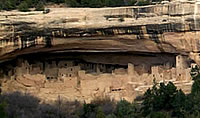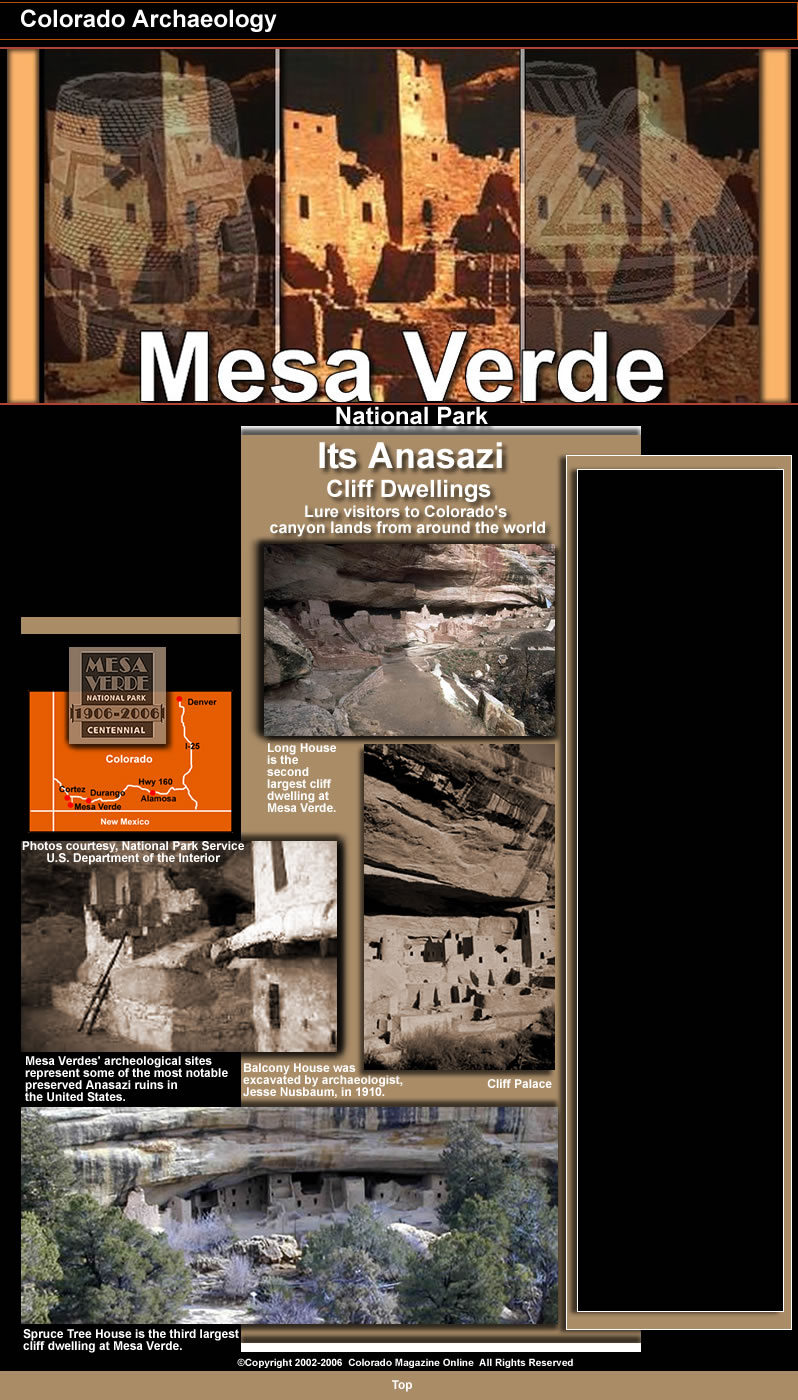Reflecting over 700 years of history,
dating from approximately A.D. 600
through A.D. 1300,
Mesa Verde comprises an 80-square mile plateau that extends about 9 miles
east-to-west and north-to-south.
Established as a national park in 1906, Mesa Verde has over 4,000 known archaeological sites. The Park is a unit of the National Park System, which is a division of the Department of Interior. Mesa Verde’s archaeological sites range from early pit houses to cliff dwellings which were constructed in later periods. Only a few of the park’s 600 known cliff dwellings have actually been excavated to date. Some sites will be left for future generations to explore, when more advanced technology is available.
The Anasazi
The ancestral Puebloans occupied the Mesa Verde area for about 750 years. From the hundreds of remaining dwellings, archaeologists have been able to ascertain a great deal about life in early America.
Mesa Verde’s first inhabitants were nomadic people who began to migrate into the area shortly after the beginning of the Christian Era from A.D.1 to A.D. 400. When they settled at Mesa Verde, they became an agricultural culture with farming replacing hunting-and-gathering as their main source of food. Corn, beans and squash were their primary crops.
They are known as the Basketmakers because of the many examples of fine basket work they left behind.
Around the year A.D. 400, the Anasazi began to build roofed dwellings known as pit houses.The pit houses were built in alcoves under cliffs and on the tops of mesas. Scores of pit house villages have been found on the mesas and two pit houses have been reconstructed at Mesa verde as visitor exhibits. During this period, the Anasazi also began to make ceramic pottery, which they embellished with with distinctive black geometric designs.
People who lived during the period of A.D. 400 to A.D. 750 are called the Modified Basketmakers.
By A.D. 750 the Anasazi culture had advanced to the use of bows and arrows for hunting. Also around that time, the Anasazi began grouping their houses together to form villages, which in fact became pueblos. Pueblo is a Spanish term meaning village. They constructed walls using adobe and stone, and houses were joined together to form compact clusters around open courts. Situated in the courts were pit houses that eventually evolved into ceremonial rooms or kivas.
Some of the cliff dwellings had apartment-like structures that rose several stories high and contained as many as 400 rooms - some of which were used for living quarters and some for storing grain.

Cliff Palace - the largest cliff dwelling in North America
The last period of the Pueblo culture at Mesa Verde, known as the Classic Pueblo Period, extended from A.D.1100 to A.D. 1300. It is estimated that by the middle of this time period as many as 5,000 people were living in pueblos scattered throughout the four corners area and the region had become a bustling trade center.
The Anasazi ultimately abandoned Mesa Verde. Although there are several theories why they left Mesa Verde, one prevailing one is that they were forced to leave their homes and seek places which provided more dependable water supplies because of a drought that struck the area beginning about A.D. 1276. The population migrated south to New Mexico and Arizona where their decedents are today's pueblo cultures.
How Mesa Verde
Was Discovered
The first known discovery of Mesa Verde was mentioned in a report by Professor J. S. Newberry, during an expedition under the leadership of Captain J. N. Macomb in 1859.
In September 1874, the Cliff House was discovered by W. H. Jackson, a photographer for the U. S. Geological and Geographical Survey, who had heard about the Mesa Verde ruins from miners and prospectors. It was one of the prospectors, John Moss, who led Jackson into Mancos Canyon, where a cliff dwelling was discovered. Other sites were also explored in the late 1800’s by government survey parties and prospectors.
Cliff Palace was discovered in 1888 by Richard Wetherill and his brother-in-law, Charles Mason, who were searching for lost cattle on their ranch. In 1889, four of the Wetherill brothers returned to Mesa Verde to explore the ruins. Over a 15-month period, they claimed to have discovered 182 cliff dwellings. The Wetherills subsequently made more trips into Mesa Verde to collect archaeological artifacts, then sold them as collections.
Baron Gustaf E. A. Nordenskiold, a scientist at the Academy of Sciences in Sweden was the first scientist to visit the cliff dwellings. He visited Mesa Verde in 1891 and collected about 600 items which he sent to Sweden. The collection now resides in the National Museum in Helsinki, Finland.
It was first suggested that the Mesa Verde area be set aside as a National Park when an editorial appeared in the Denver Tribune Republican, December 12, 1886. It was not until February 22,1901 that a bill to create a National Park at Mesa Verde was introduced in Congress, but that bill was never returned from the Public Lands Committee.
During the period of 1901 to 1903, two more bills sponsoring the creation of a park were introduced in the House of Representatives, during the 57th Congress. Neither bill was approved, however, congressional authority was secured to authorize the Secretary of the Interior to negotiate for the relinquishment of the Mesa Verde tract from the Ute Indians and for an appropriation for a survey of the area.
Mesa Verde National Park was finally created June 29, 1906, when a bill was passed by the 59th Congress. It was signed by President Theodore Roosevelt. Then in June, 1906, the "Act for the Preservation of American Antiquities," was passed - which made it a federal crime to collect or destroy any historic or prehistoric object or building on federally owned land.
In 1908, Mesa Verde was opened to the public, when excavation and repair of the major sites was begun under the direction of Jesse Walter Fewkes, an archaeologist with the Smithsonian Institution.
Today, Mesa Verde offers visitors a fascinating peak into the past with many interesting cliff dwelling tours and exhibits.
For
Tourist Information,
Visit:
Story information gathered from the NPS website and other web sources.


